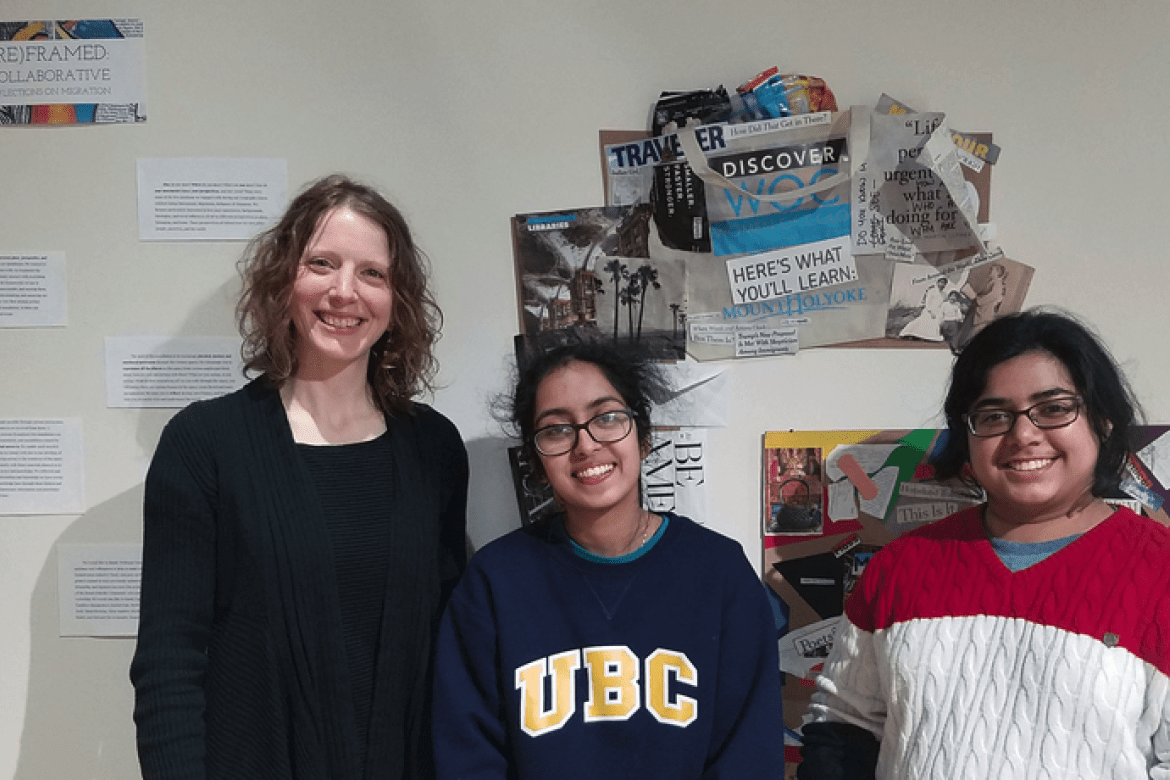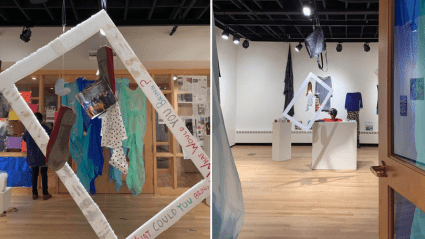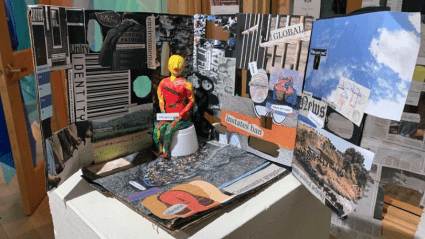(Re)framed: collaborative reflections on migration

An art installation that grew out a creative project for the Global Movements: Migrations, Refugees, and Diasporas course, taught by Serin Houston, assistant professor of geography and international relations.
What do you think about when you hear the word “home”? What about the word “migration,” or “belonging”? What do you think other people associate with these words? These are some of the questions I explored my senior year. And, in typical Mount Holyoke fashion, my exploration spilled out of the classroom and into completely unexpected spaces.
Over the spring semester, my friend Anya Nandkeolyar ’19 and I designed, created and exhibited an art installation in the Blanchard Art Gallery. We sourced materials from places we’d never been and found support all over campus.
The goal
With our installation, we wanted to make the viewer interrogate their own preconceptions about movement. Everybody has a frame of mind that is influenced by their personal experiences. Figuring out what that framework is — and how past experiences inform it — can inspire a reflective process that may help reinforce, or further nuance, your beliefs. Thinking about our own perspectives has been a really big part of this project for me and Anya, and we were hoping to help our viewers do that, too.

Framing questions
To that end, we made a lot of literal frames. Some were traditional — but broken — wooden picture frames. Others we made out of books or plastic. We even used the door of a broken microwave as a sort of frame.
To frame the viewer’s initial experience, we collaged over the glass facade of the gallery. Before entering, the viewer could only look through cutouts in the covered surface. To help guide the viewer’s journey once they entered, a dotted line wound around the floor, starting at the collaborative wall and ending near the collage about surveillance.
Scattered throughout the room were collages, frames and sculptures that inspired a variety of questions: Who is seen, or unseen? When are people allowed, or not allowed, into a space? What is the function of borders? How does migration tie in with climate change? How does surveillance affect the way people move?
The collaborative wall included collages made by attendees of a workshop we hosted during Mount Holyoke’s BOOM! 2019 conference, an annual learning symposium dedicated to diversity, equity and inclusion. Anya and I wanted to expand our project to narratives beyond those of our own experiences, and Kijua Sanders-McMurtry, vice president for equity and inclusion and chief diversity officer, helped us add our project to the BOOM! lineup.

Inspiration, in miniature
The idea for our installation grew out a creative project for the Global Movements: Migrations, Refugees, and Diasporas course, taught by Serin Houston, assistant professor of geography and international relations. This class asked us to grapple with our own connections to themes such as migration, belonging and home — and inspired me and Anya to make a miniature art installation.
Our first project made us realize that we wanted to continue to use art to explore these themes, possibly by creating a bigger art installation. We talked to Serin, who enthusiastically agreed to advise our independent study. With her help, we created a syllabus, course goals and a schedule.
Buoyed by support
Over the past few months, it was exciting — and unexpected — to find so many people across different campus spaces who were willing to support our project. Connecting with them about what was possible also gave our ideas space to grow and change.
Beyond our new advisor, we worked with Ligia Bouton and Gina Siepel in the art studio department on sourcing sustainable materials. Ligia also helped us think through the feasibility of our project. Shani Mensing ’15, coordinator and technical specialist for the Fimbel Maker and Innovation Lab, let us run our workshop out of the Fimbel Lab and also participated in our discussion. We talked to staff members from facilities management about using recycled materials on campus. Biology department chair Rachel Fink and staff at the Talcott Greenhouse helped us consider how we could tie in the natural world and gave us some materials, too. Debra LaBonte, academic coordinator in the Geology & Geography department, helped us access academic resources. We also got experience in applying for grants and received funding from the Inclusiveness Initiative Fund.
I never expected to spend part of my senior year collaging and sculpting. I never expected to experience the excitement of having an art installation go live. For me and Anya, this process has affirmed that support may be all around you, if you know where to look. And we learned that anything can happen when you dare to question your own preconceived notions of what is possible.